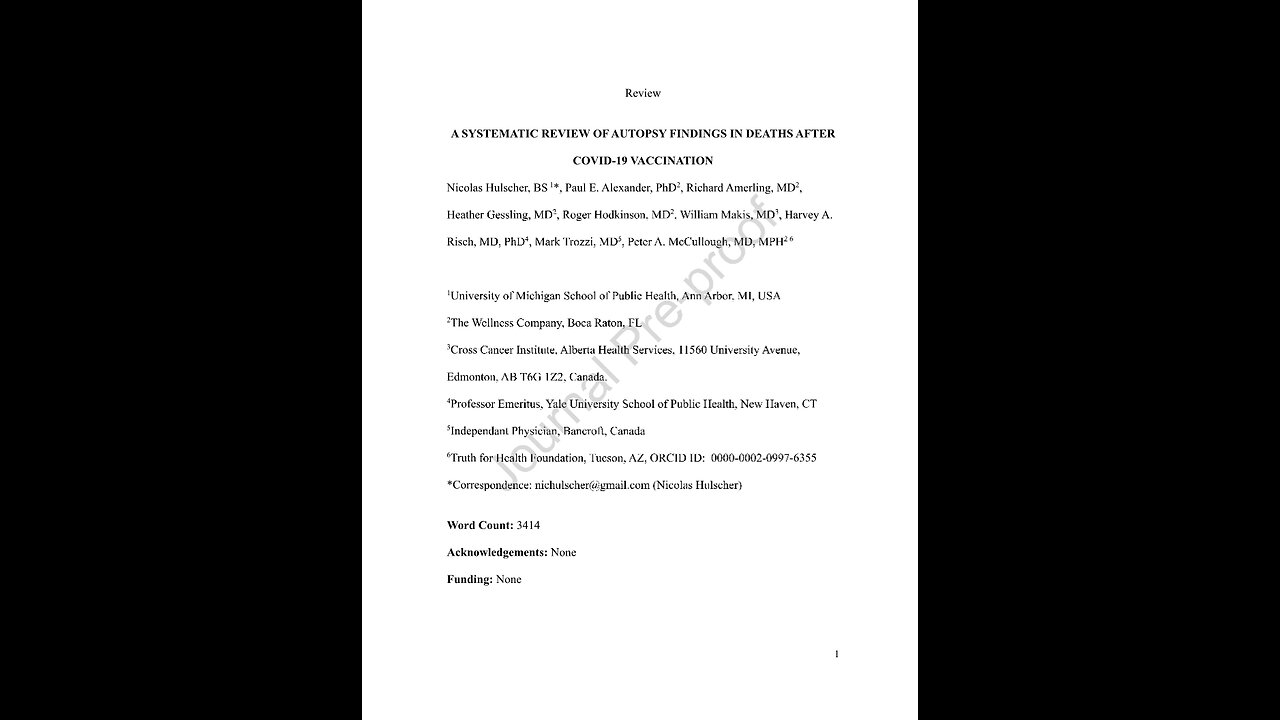Premium Only Content

A systematic review of autopsy findings in deaths after covid-19 vaccination. A Puke (TM) Audiopaper
To appear in: Forensic Science International.
Received date: 9 October 2023.
Revised date: 17 January 2024.
Accepted date: 17 June 2024.
Autopsy, necropsy, COVID-19, COVID-19 vaccines, mRNA, SARS CoV-2 vaccination, death, excess mortality, spike protein, organ system.
DOI: https://doi.org/10.1016/j.forsciint.2024.112115
Edited for machine speech, for example, % signs become “percent”, numbered references [14] have been removed, see the original pdf text, and long names and number have been simplified, 1,556,050 becomes over one and a half million.
A systematic review of autopsy findings in deaths after covid-19 vaccination.
Nicolas Hulscher, William Makis, Peter McCullough and others.
Abstract.
Background: The rapid development of COVID-19 vaccines, combined with a high number of adverse event reports, have led to concerns over possible mechanisms of injury including systemic lipid nanoparticle (LNP) and mRNA distribution, Spike protein-associated tissue damage, thrombogenicity, immune system dysfunction, and carcinogenicity. The aim of this systematic review is to investigate possible causal links between COVID-19 vaccine administration and death using autopsies and post-mortem analysis.
Methods: We searched PubMed and ScienceDirect for all published autopsy and necropsy reports relating to COVID-19 vaccination up until May eighteenth, 2023. All autopsy and necropsy studies that included COVID-19 vaccination as an antecedent exposure were included. Because the state of knowledge has advanced since the time of the original publications, three physicians independently reviewed each case and adjudicated whether or not COVID-19 vaccination was the direct cause or contributed significantly to death.
Results: We initially identified 678 studies and, after screening for our inclusion criteria, included 44 papers that contained 325 autopsy cases and one necropsy case. The mean age of death was 70.4 years. The most implicated organ system among cases was the cardiovascular (49 percent), followed by hematological (17 percent), respiratory (11 percent), and multiple organ systems (7 percent). Three or more organ systems were affected in 21 cases. The mean time from vaccination to death was 14.3 days. Most deaths occurred within a week from last vaccine administration. A total of 240 deaths (73.9 percent) were independently adjudicated as directly due to or significantly contributed to by COVID-19 vaccination, of which the primary causes of death include sudden cardiac death (35 percent), pulmonary embolism (12.5 percent), myocardial infarction (12 percent), VITT (7.9 percent), myocarditis (7.1 percent), multisystem inflammatory syndrome (4.6 percent), and cerebral hemorrhage (3.8 percent).
Conclusions: The consistency seen among cases in this review with known COVID-19 vaccine mechanisms of injury and death, coupled with autopsy confirmation by physician adjudication, suggests there is a high likelihood of a causal link between COVID-19 vaccines and death. Further urgent investigation is required for the purpose of clarifying our findings.
Keywords: Autopsy, necropsy, COVID-19, COVID-19 vaccines, mRNA, SARS CoV-2 vaccination, death, excess mortality, spike protein, organ system
Introduction.
As of May thirty-first, 2023, SARS-CoV-2 has infected an estimated seven hundred and sixty million people globally, resulting in almost seven million deaths. As a direct response to this worldwide catastrophe, governments adopted a coordinated approach to limit caseloads and mortality utilizing a combination of non-pharmaceutical interventions, NPI’s, and novel gene-based vaccine platforms. The first doses of vaccine were administered less than 11 months after the identification of the SARS-CoV-2 genetic sequence, in the United States, under the Operation Warp Speed initiative, which represented the fastest vaccine development in history with limited assurances of short and long-term safety. Currently, roughly 69 percent of the global population have received at least one dose of a COVID-19 vaccine. The most frequently utilized COVID-19 vaccine platforms include inactivated virus, Sinovac CoronaVac, protein subunit, Novavax, viral vector, AstraZeneca, Johnson and Johnson, and messenger RNA, Pfizer, Moderna. All utilize mechanisms that can cause serious adverse events. Most involve the uncontrolled synthesis of the Spike glycoprotein as the basis of the immunological response.
Circulating Spike protein is the likely deleterious mechanism through which COVID-19 vaccines produce adverse effects. Spike protein and, or subunits, peptide fragments can trigger ACE2 receptor degradation and destabilization of the renin–angiotensin system (RAS), resulting in severe thrombosis. Spike protein activates platelets, causes endothelial damage, and directly promotes thrombosis. Moreover, Immune system cells that uptake lipid nanoparticles (LNPs) from COVID-19 vaccines can then systemically distribute Spike protein and microRNAs via exosomes, which may cause severe inflammatory consequences. Further, long term cancer control may be jeopardized in those injected with mRNA COVID-19 vaccines because of interferon regulatory factor (IRF) and tumor suppressor gene dysregulation. Moreover, a possible causal link between COVID-19 vaccines and various diseases has been found, including neurological disorders, myocarditis, blood platelet deficiencies, liver disease, weakened immune adaptability, and cancer development. These findings are supported by the finding that recurrent COVID-19 vaccination with genetic vaccines may trigger unusually high levels of IgG4 antibodies which can lead to immune system dysregulation, and contribute to the emergence of autoimmune disorders, myocarditis, and cancer growth.
Neurotoxic effects of Spike protein may cause or contribute to the post COVID syndrome, including headache, tinnitus, autonomic dysfunction, and small fiber neuropathy. Specific to the administration of viral vector COVID-19 vaccines, AstraZeneca, Johnson and Johnson, a new clinical syndrome called vaccine-induced immune thrombotic thrombocytopenia (VITT) was identified in 2021 and characterized by the development of thromboses at atypical body sites combined with severe thrombocytopenia after vaccination. The pathogenesis of this life-threatening side effect is currently unknown, though it has been proposed that VITT is caused by post-vaccination antibodies against platelet factor 4 (PF4) triggering extensive platelet activation. mRNA-based vaccines rarely cause VITT, but they are associated with myocarditis, or inflammation of myocardium. The mechanisms for the development of myocarditis after COVID-19 vaccination are not clear, but it has been hypothesized that it may be caused by molecular mimicry of Spike protein and self-antigens, immune response to mRNA, and dysregulated cytokine expression. In adolescents and young adults diagnosed with post-mRNA vaccine myocarditis, free Spike protein was detected in the blood while vaccinated controls had no circulating Spike protein. It has been demonstrated that SARS-CoV-2 Spike mRNA vaccine sequences can circulate in the blood for at least 28 days after vaccination.
These data indicate that adverse events may occur for an unknown period after vaccination, with Spike protein playing an important potential etiological role. A Freedom of Information Act (FOIA) document obtained from the Australian Government, titled Nonclinical Evaluation of BNT COVID-19 vaccine (COMIRNATY), shows systemic distribution of the LNPs containing mRNA after vaccine administration in rats, concluding that LNPs reached their highest concentration at the injection site, followed by the liver, spleen, adrenal glands, ovaries (females), and bone marrow (femur) over 48 hours. Further, LNPs were detected in the brain, heart, eyes, lungs, kidneys, bladder, small intestine, stomach, testes (males), prostate (males), uterus (females), thyroid, spinal cord, and blood. This biodistribution data suggests that Spike protein may be expressed in cells from many vital organ systems, raising significant concerns regarding the safety profile of COVID-19 vaccines. Given the identified vaccination syndromes and their possible mechanisms, the frequency of adverse event reports is expected to be high, especially given the vast number of vaccine doses administered globally. Through May fifth, 2023, the Vaccine Adverse Events Reporting System (VAERS) contained over one and a half million adverse event reports associated with COVID-19 vaccines, including 35,324 deaths, 26,928 myocarditis and pericarditis, 19,546 heart attacks, and 8,701 thrombocytopenia reports.
If the alarmingly high number of reported deaths are indeed causally linked to COVID-19 vaccination, the implications could be immense, including: the complete withdrawal of all COVID-19 vaccines from the global market, suspension of all remaining COVID-19 vaccine mandates and passports, loss of public trust in government and medical institutions, investigations and inquiries into the censorship, silencing and persecution of doctors and scientists who raised these concerns, and compensation for those who were harmed as a result of the administration of COVID-19 vaccines. Using VAERS data alone to establish a causal link between COVID-19 vaccination and death, however, is not possible due to many limitations and confounding factors. In 2021, Walach et al indicated that every death after COVID-19 vaccination should undergo an autopsy to investigate the mechanisms of harm. Autopsies are one of the most powerful diagnostic tools in medicine to establish cause of death and clarify the pathophysiology of disease. COVID-19 vaccines, with plausible mechanisms of injury to the human body and a substantial number of adverse event reports, represent an exposure that may be causally linked to death in some cases. The purpose of this systematic review is to investigate possible causal links between COVID-19 vaccine administration and death using autopsies and post-mortem analysis.
Methods.
Data Sources and Search Strategy We performed a systematic review of all published autopsy and necropsy reports relating to COVID-19 vaccination through May eighteenth, 2023. The following databases were used: PubMed and Science Direct. The following keywords were used: COVID-19 Vaccine, SARS-CoV-2 Vaccine, or COVID Vaccination, and Post-mortem, Autopsy, or Necropsy. All possible keyword combinations were manually searched. The search was not restricted to any language. All selected studies were screened for relevant literature contained in their references.
Eligibility Criteria and Selection Process.
All original articles, case reports and case series that contain autopsy or necropsy, gross and histologic analysis of organ and tissues, results with COVID 19 vaccines as an antecedent exposure were included. Review articles, systematic reviews, meta-analyses, papers with no autopsy or necropsy results, non-human studies, and papers with no reported COVID-19 vaccination status were excluded. Two authors (NH and PAM) independently screened the full text of all retrieved studies to assess their eligibility for inclusion and removed all ineligible, duplicate studies.
Any disagreements for inclusion of an article were resolved by discussion until agreement was reached. Data Extraction and Analysis From the selected studies, two authors (NH and PAM) independently extracted the following data into Microsoft Excel: year published, country where the study conducted, and all available individual case information, age, sex, brand of COVID-19 vaccine, cumulative number of COVID-19 vaccine doses administered, days from last COVID-19 vaccine administration to death, post mortem findings, and type of post-mortem procedure.
Any discrepancies in data were resolved by discussion and re-extraction. Given the presence of some missing data, all available information was used to calculate descriptive statistics. Estimated age, exact age not given, and inferred time from last vaccine administration to death, no definitive time given, were excluded from calculations and figures. Because the state of knowledge regarding COVID-19 vaccine safety has advanced since the time of the original publications, we performed a contemporary review: three physicians (RH, WM, PAM) with experience in death adjudication and anatomical, clinical pathology independently reviewed the available evidence of each case (Table S1), including demographic information, clinical vignette, vaccination data, gross and histologic autopsy, necropsy findings and determined whether or not COVID-19 vaccination was the direct cause or contributed significantly to the mechanism of death described.
The physicians assessed the temporal relationships, strength of evidence and consistency of findings with known causes of vaccine death, and other potential etiologies to adjudicate each case. Agreement was reached when two or more physicians adjudicated a case concordantly. For the study by Chaves, only cardiovascular and hematological system related cases were adjudicated as being linked to the vaccine due to a high probability of COVID-19 vaccination contributing to death and missing individual case information for the other individuals.
Results.
A database search yielded 678 studies that had potential to meet our inclusion criterion. 562 duplicates were screened out. Out of the remaining 116 papers, 36 met our specified inclusion criterion. Through further analysis of references, we located 18 additional papers, with 8 of them meeting our inclusion criterion. In total, we found 44 studies that contained autopsy or necropsy reports of COVID-19 vaccinees (Figure 1).
Table 1 summarizes the 44 studies, which includes a total of 325 autopsy cases and 1 necropsy case (heart). The mean age of death was 70.4 years and there were 139 females (42.6 percent). Most received a Pfizer, BioNTech vaccine (41 percent), followed by Sinovac (37 percent), AstraZeneca (13 percent), Moderna (7 percent), Johnson and Johnson (1 percent), and Sinopharm (1 percent).
The cardiovascular system was most frequently implicated (49 percent), followed by hematological (17 percent), respiratory (11 percent), multiple organ systems (7 percent), neurological (4 percent), immunological (4 percent), and gastrointestinal (1 percent). In 7 percent of cases, the cause of death was either unknown, non-natural, drowning, head injury, or infection (Figure 2). One organ system was affected in 302 cases, two in 3 cases, three in 8 cases, and four or more in 13 cases (Figure 3).
Table 2 shows the number and proportion of each reported cause of death. Sudden cardiac death was the most common cause of death (21.2 percent), followed by myocardial infarction (9.5 percent), pulmonary embolism (9.5 percent), ischemic heart disease (6.8 percent), VITT (5.8 percent), COVID-19 pneumonia (5.8 percent), myocarditis, pericarditis (5.5 percent), cerebral, subarachnoid hemorrhage (2.8 percent), coronary artery disease (2.5 percent), respiratory failure (2.5 percent), and unexplained (2.5 percent).
The number of days from vaccination until death was 14.3 (mean), 3 (median) irrespective of dose, 7.8 (mean), 3 (median) after one dose, 23.2 (mean), 2 (median) after two doses, and 5.7 (mean), 2 (median) after three doses. The distribution of days from last vaccine administration to death is highly right skewed, showing that most of the deaths occurred within a week from last vaccination (Figure 4). 240 deaths (73.9 percent) were independently adjudicated by three physicians to be significantly linked to COVID-19 vaccination (Table S1). Among adjudicators, there was complete independent agreement (all three physicians) of COVID-19 vaccination contributing to death in 203 cases (62.5 percent). The one necropsy case was judged to be linked to vaccination with complete agreement.
Among the 240 deaths that have been adjudicated as being significantly linked to COVID-19 vaccination, most received a Sinovac vaccine (46.3 percent), followed by Pfizer (30.1 percent), AstraZeneca (14.6 percent), Moderna (7.5 percent).
Johnson and Johnson (1.3 percent), and Sinopharm (0.8 percent).
The mean age of death was 55.8, the number of days from vaccination until death was 11.3 (mean), 3 (median) irrespective of dose.
And the primary causes of death include sudden cardiac death (35 percent), pulmonary embolism (12.5 percent), myocardial infarction (12 percent), VITT (7.9 percent), myocarditis (7.1 percent), multisystem inflammatory syndrome (4.6 percent), and cerebral hemorrhage (3.8 percent).
Discussion.
Among all published autopsy reports relating to COVID-19 vaccination, we found by independent adjudication that 73.9 percent of deaths were attributable to fatal COVID-19 vaccine injury syndromes (Table S1). The cardiovascular system was by far the most implicated organ system in death, followed by hematological, respiratory, multiple organ systems, neurological, immunological, and gastrointestinal systems (Figure 2), with three or more organ systems affected in 21 cases (Figure 3). Sudden cardiac death, myocardial infarction, myocarditis, pericarditis, pulmonary embolism, VITT, brain hemorrhage, multi-organ failure, respiratory failure, and cytokine storm were the reported causes of death in the majority of cases (Table 2). The majority of deaths occurred within a week from last vaccine administration (Figure 4). These results corroborate known COVID-19 vaccine-induced syndromes and show significant, temporal associations between COVID-19 vaccination and death involving multiple organ systems, with a predominant implication of the cardiovascular and hematological systems. Criteria of causality from an epidemiological perspective have been met including biological plausibility, temporal association, internal and external validity, coherence, analogy, and reproducibility with each successive case report of death after COVID-19 vaccination combined with population-based studies describing mortality among the vaccinated.
Our findings amplify concerns regarding COVID-19 vaccine adverse events and their mechanisms. COVID-19 vaccine-induced myocarditis and myocardial infarction have been significantly well-described in the peer-reviewed literature, explaining the high proportion of cardiovascular deaths seen in our study. Spike protein’s deleterious effects, especially on the heart, further corroborate these findings. Our results also highlight the involvement of multiple organ systems described as Multisystem Inflammatory Syndrome (MIS) and reported following COVID-19 vaccination in both children and adults. A possible mechanism by which MIS occurs after vaccination could be the systemic distribution of the LNPs containing mRNA after vaccine administration and the consequent systemic Spike protein expression and circulation resulting in system-wide inflammation. A significant proportion of cases were due to hematological system adverse events, which is not surprising given that VITT and pulmonary embolism (PE) have been reported in the literature as serious adverse events following COVID-19 vaccination. Deaths caused by adverse effects to the respiratory system were also relatively common in our review, a finding that is in line with the possibility of developing acute respiratory distress syndrome (ARDS) or drug-induced interstitial lung disease (DIILD) after COVID-19 vaccination.
Although uncommon among cases in this study, immunological, neurological, and gastrointestinal adverse events can still occur after COVID-19 vaccination and, as with the cardiovascular system, may be directly or indirectly caused by the systemic expression or circulation of Spike protein. Given the average time (14.3 days) in which cases died after vaccination, a temporal association between COVID-19 vaccination and death among most cases is further supported by the finding that SARS-CoV-2 Spike mRNA vaccine sequences can circulate in the blood for at least 28 days after vaccination. Most of the deployed vaccine platforms are associated with death, suggesting that they share a common feature that causes adverse effects, which is most likely Spike protein.
The large number of COVID-19 vaccine induced deaths evaluated in this review is coherent with multiple papers that report excess mortality after COVID-19 vaccination. Pantazatos and Seligmann found that all-cause mortality increased 0-5 weeks post-injection in most age groups resulting in 146,000 to 187,000 vaccine-associated deaths in the United States between February and August of 2021. With similar findings, Skidmore estimated that 278,000 people may have died from the COVID-19 vaccine in the United States by December 2021. These concerning results were further elucidated by Aarstad and Kvitastein, who found that among 31 countries in Europe, a higher population COVID-19 vaccine uptake in 2021 was positively correlated with increased all-cause mortality in the first nine months of 2022 after controlling for alternative variables.
Since the initiation of the global COVID-19 vaccination campaign, excess mortality from non-COVID-19 causes has been detected in many countries, suggesting a common adverse exposure among the global population. Pantazatos estimated that VAERS deaths are underreported by a factor of 20. If we apply this underreporting factor to the May fifth, 2023, VAERS COVID-19 vaccine death report number of 35,324, the amount of deaths becomes an estimated 706,480 in the United States and other countries that utilize VAERS. If this extrapolated number of deaths were true, it would implicate the COVID-19 vaccines as a contributing factor to excess mortality among populations. There have been several studies that have analyzed the causal relationship between COVID-19 vaccines and death. Maiese et al and Sessa et al used the conclusions of their included studies to assess the causal relationship between COVID-19 vaccination and death. In these studies, they found 14 and 15 deaths with a demonstrated causal link to COVID-19 vaccination, respectively. However, the collected conclusion methodology used in these studies is flawed for fully evaluating causal links at this time, specifically with COVID-19 vaccines, because they are novel medical products and new safety data is an inevitability as time advances.
The average timeframe for a proper safety and efficacy evaluation for a vaccine is about 10.71 years. Thus, collected conclusion methodology should only be considered for studies that have been published at least a few years after vaccine development to retain valid conclusions. For example, a paper published in 2021 indicates the AstraZeneca vaccines as safe with no links to serious adverse events including VITT, however, after more observation time, other researchers found a link between AstraZeneca vaccines and fatal VITT prompting widespread market withdrawal. Pomara et al used the World Health Organization adverse event following immunization (WHO AEFI) guidelines, which we agree is a great method to assess causality between COVID-19 vaccination and death. In this paper, the researchers concluded that there may exist a causal link between COVID-19 vaccination and death from VITT. Unfortunately, we could not properly utilize the WHO AEFI methodology and complete the required checklist for our included cases due to missing needed case information. This methodology requires deceased subjects, extensive data, and IRB approval and can’t be utilized in a systematic review. Tan et al utilized incidence statistics to analyze the relationship between COVID-19 vaccines and death, and found a higher incidence of serious side effects compared to the pre-licensing clinical trials. This method is not applicable to our study because the included autopsy reports do not present incidence statistics.
Because the aforementioned methodologies were found to be incompatible with our study, we decided to utilize adjudication procedures helmed by medical professionals with relevant expertise to determine possible links between COVID-19 vaccines and death. Independent adjudication methodology was used by Hulscher et al to evaluate causal links between COVID-19 vaccines and death, where they found a highly probable causal link between COVID-19 vaccination and death from myocarditis in 28 autopsy cases.
Our study has all the limitations of bias as it applies to selection of papers and independent adjudication of the case material. We used standard systematic search methodology to limit study selection bias and three independent reviewers of the case information, so we were not influenced by the bias of the investigators and their connection, if any, with COVID-19 vaccination. Our rendered conclusions from the autopsy findings are based on the evolving understanding of COVID-19 vaccines, which differs markedly from when the referenced studies were published, making a bias assessment for those studies inapplicable. Moreover, our paper has all the limitations of systematic reviews of previously published case reports including selection bias at the level of referral for autopsy and acceptance into the peer reviewed literature. We believe publication bias could have had a large influence on our findings because of the global push for mass vaccination by governments, medical societies, and academic medical centers coupled with investigator hesitancy to report adverse developments with new genetic products widely recommended for both caregivers and patients.
Finally, confounding variables, particularly concomitant illnesses, infection, drug interactions, and other factors not accounted for, could have played roles in the causal pathway to death.
In summary, among the universe of published autopsies performed after COVID-19 vaccination available to date, with a contemporary and independent review, we found that in 73.9 percent of cases, COVID-19 vaccination was the direct cause or significantly contributed to death. The consistency seen among cases in this review with previously reported COVID-19 vaccine serious adverse events, their known fatal mechanisms, coupled with our independent adjudication, suggests there is a high likelihood of a causal link between COVID-19 vaccines and death. The implications of our study apply to cases of unanticipated death without antecedent illness among COVID-19 vaccine recipients.
We can infer that in such cases, death may have been caused by COVID-19 vaccination. Further urgent investigation is required to build upon our results and further elucidate the pathophysiologic mechanisms of death with the goal of risk stratification and avoidance of death for the large numbers of individuals who have taken or will receive one or more COVID-19 vaccines in the future.
Autopsies should be performed on all diseased individuals that have received one or more COVID-19 vaccines. Clinical monitoring of COVID-19 vaccine recipients is indicated for a period of at least one year after vaccination to ensure the absence of serious adverse events that may lead to death.
Ninety-One references.
Highlights.
We found that 73.9 percent of deaths were directly due to or significantly contributed to by COVID-19 vaccination.
Our data suggest a high likelihood of a causal link between COVID-19 vaccination and death.
These findings indicate the urgent need to elucidate the pathophysiologic mechanisms of death with the goal of risk stratification and avoidance of death for the large numbers of individuals who have taken or will receive one or more COVID-19 vaccines in the future.
This review helps provide the medical and forensic community a better understanding of COVID-19 vaccine fatal adverse events
Figure 1: Preferred Reporting Items for Systematic Reviews and Meta-Analyses (PRISMA) Flow Diagram Detailing the Study Selection Process.
Figure 2: Proportion of Cases by Affected Organ System.
Figure 3: Number of Affected Organ Systems by Cases.
Figure 4: Distribution of Time from Last Vaccine Administration to Death Among Cases.
Table 1: Characteristics of Included Autopsy and Necropsy Studies Examining Potential COVID-19 Vaccine-Related Deaths. Partial, full in original PDF.
Table 2: Number and Proportion of Reported Causes of Death Among Included Cases.
Partial, full in original PDF.
-
 LIVE
LIVE
Rebel News
1 hour agoMontreal Pride drama, Jewish father attacked, Atlantic Canada climate lockdown grows | Rebel Roundup
807 watching -
 LIVE
LIVE
IrishBreakdown
2 hours agoNotre Dame Must Continue Its Dominance Over The ACC
359 watching -
 12:50
12:50
itsSeanDaniel
19 hours agoSmug CNN Host STUNNED by GENIUS Trump Aide
10.2K12 -

Flyover Conservatives
12 hours agoTHE GREAT SILVER SETUP FOR SUCCESS. My prediction: It’s about to pop, and BIG! | FOC Show
17.9K1 -
 DVR
DVR
The Shannon Joy Show
2 hours ago🔥🔥Techno-Fascism Rising Under Trump With NVIDIA Scheme? LIVE EXCLUSIVE With Peter Schiff!🔥🔥
22K3 -
 33:22
33:22
VINCE
4 hours agoThe Problem With The Republican Party (w/ Shawn Farash) | Episode 100 - 08/11/25
183K154 -
 2:13:02
2:13:02
The White House
4 hours agoPresident Trump Holds a Press Conference, Aug. 11, 2025
58.7K58 -
 1:03:57
1:03:57
Grant Stinchfield
2 hours ago $0.16 earnedTrump to Take Back D.C.: Swamp Panic as Federal Takeover Looms
19.2K3 -
 LIVE
LIVE
LFA TV
18 hours agoLFA TV ALL DAY STREAM - MONDAY 8/11/25
3,891 watching -
 LIVE
LIVE
Law&Crime
3 hours ago $1.57 earnedLIVE: Wife Dismembered Murder Trial – GA v. Nicholas Kassotis – Day 5 – Part 2
101 watching